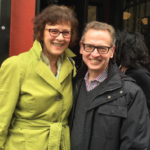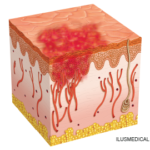 Recently, the Vasculitis Foundation, in collaboration with a group of physicians and vasculitis investigators in the U.S. and Latin America (i.e., Mexico, Colombia, Peru, Chile and Argentina), launched an educational series of videos in Spanish called, Aprendiendo de Vasculitis.
Recently, the Vasculitis Foundation, in collaboration with a group of physicians and vasculitis investigators in the U.S. and Latin America (i.e., Mexico, Colombia, Peru, Chile and Argentina), launched an educational series of videos in Spanish called, Aprendiendo de Vasculitis.
“The goal of these videos is to provide education to all Spanish-speaking patients,” explains Sebastian E. Sattui, MD, MS, an assistant professor of medicine and director of the UPMC Vasculitis Center at the University of Pittsburgh School of Medicine.
This initial video series includes the following topics:
- What is vasculitis?
- Creating your medical team;
- Glucocorticoids;
- Medications used for the treatment of vasculitis;
- What is remission?
- Dealing with damage caused by vasculitis and complications from treatment; and
- Patient’s perspective of living with vasculitis.

Dr. Sattui
“The goal was to cover basic topics that are relevant to the care of patients living with vasculitis, understanding that most patient-directed information is in English,” Dr. Sattui says. The videos are available in the patient education section of the Vasculitis Foundation, as well as on YouTube.
“Dissemination of these videos and materials has been done through all social media channels of the Vasculitis Foundation; local patient organizations in South America, with special support from Vasculitis Chile; and the Pan American League of Rheumatology Associations (PANLAR),” Dr. Sattui says.
The Vasculitis Foundation is also translating its vasculitis disease-specific brochures into Spanish.
Local organizations in Latin America and Spain also have activities to provide information to patients, but most of these organizations tend to point their patients to the resources at the Vasculitis Foundation because it is “one of the largest and most established patient organizations for people living with vasculitis,” Dr. Sattui says.
“Previous efforts have been primarily focused on specific sessions or webinars by existing patient groups. The goal of this series is to create patient friendly resources that will permanently be accessible to all patients,” he adds.
Other Sources
Other reputable sources for patient education videos and materials in languages other than English include the ACR, the Lupus Foundation of America and the National Institute of Arthritis and Musculoskeletal and Skin Diseases (NIAMS). Print materials on the diagnosis, treatment and prevention of a range of health conditions related to arthritis, musculoskeletal, and skin diseases are available through NIAMS in English, Spanish, Chinese, Korean and Vietnamese. NIAMS also provides social media resources aimed at helping people take steps to improve their health.
The Centers for Disease Control and Prevention is also a trustworthy source for information available in a number of different languages. Information on diseases and conditions comes in various formats available for sharing and downloading.
The ACR provides a wide variety of resources for patient education. “We offer more than 100 patient fact sheets regarding individual autoimmune/rheumatic conditions and various treatments that are understandable at a sixth grade reading level through our website,” explains Mohammad Ursani, MD, a private practice rheumatologist in The Woodlands, Texas, who serves as chair of the ACR Communications and Marketing Committee. “In addition to print materials, we have created informational whiteboard videos, infographics, social media graphics and fact sheets on such popular conversations as pregnancy and rheumatic disease, cannabis use for pain management, and COVID-19 and other vaccine information.”

Dr. Ursani
The materials from the ACR are distributed primarily through electronic media (e.g., blog posts and newsletters) and educational videos. Rheumatology professionals and patients can also print fact sheets and infographics directly from the website. “Thus far, we have translated our disease and treatment information section into Spanish,” Dr. Ursani says.
The Lupus Foundation of America produces patient education materials in the three most common languages in the U.S.—English, Spanish and Chinese.
“Approximately 20% of inquiries to our health education specialists are in Spanish, so we know a significant need exists among people with lupus for Spanish language resources,” says Melissa G. French, MS, content director at the Lupus Foundation of America, Washington, D.C. “Our Spanish-speaking health education specialists provide answers to people’s questions in Spanish.”
Videos from the Lupus Foundation of America provide different kinds of information. Some videos cover the basics of understanding lupus, while others provide more in-depth information on the disease. “A number of our videos offer tips and strategies on living better with lupus. We also have videos explaining many of our programs, such as SELF—Strategies to Embrace Living with Lupus Fearlessly, our online self-management tool—and our health education specialists, as well as recordings from our education programs, Lupus & You.
“Finally, we also work with people living with lupus to create videos about their experiences and to highlight their resilience. All of our videos are designed to educate, inform and connect people with lupus and their caregivers,” Ms. French explains. “We also produce one to three Spanish-language episodes of our podcast, The Expert Series, every year,” she adds.
The Lupus Foundation of America has videos on its website and posts videos on its social media channels. “Our YouTube channel has about 350 videos covering a wide range of topics related to lupus. Last year we posted approximately 50 videos to Instagram that were either created by Lupus Foundation of America staff or by trusted partners,” Ms. French says.
Johns Hopkins Medicine’s Rheum.TV is another information platform created to educate patients who are living with a rheumatic disease. Although available only in English, Rheum.TV includes more 140 videos on a wide range of diseases, including exercise, medication and lifestyle tips. “Our videos have had more than 11 million views,” says Victoria Ruffing, RN, BC-Rheumatology, director of nursing and patient education at the Johns Hopkins Arthritis Center, Baltimore. “They are available through Rheum.TV, YouTube and Facebook,” she says.
Scope of Need
According to Dr. Ursani, there is a significant need for patient education and outreach content. “Although awareness of rheumatic and autoimmune diseases is increasing, there is a significant need to continue to educate the public, healthcare providers and policymakers to help improve outcomes for our patients,” he says.
The materials from the ACR have proved beneficial for providers and their patients.
“Last year, the diseases and treatments patient fact sheets ranked as the second-most sought-after pages on the ACR website, receiving nearly 3 million views. Additionally, month after month, the patient-focused newsletter has an open rate of 33.5%, which exceeds the industry standard, and the patient-focused social media audience and engagement rate increased,” Dr. Ursani says.
Dr. Sattui explains that “being diagnosed with any chronic condition is challenging, but the challenges are even greater when the disease is rare and knowledge and awareness of the condition are limited. Most resources have been developed in the U.S. and Europe, where the majority of research takes place and where the largest patient organizations exist. Providing patients access to information is crucial, and this should be available to all patients independent of their native language.
“Knowledge empowers patients to be more active in their care as they work with their medical team to achieve good outcomes. It also allows patients to educate their family and friends, provide more visibility to these rare diseases and create awareness. This is particularly important for rare diseases such as vasculitis,” Dr. Sattui adds.
For people with lupus, the need for accurate, easy-to-understand health and medical information is particularly acute. “Lupus is a complex illness and people who have it often have the additional challenge of fatigue and brain fog, which can complicate their ability to understand the disease and participate in treatment decisions and disease self-management. This is compounded when people are not comfortable communicating in English,” Ms. French says.

Ms. French
Providing health education materials that are easy to understand is beneficial to both patients and clinicians. “Patients are able to understand their disease and participate more fully in their care, which leads to better health outcomes. Clear communication also helps build trust between patients and their doctors, increasing the opportunity to develop an open and productive relationship,” says Ms. French.
Health Literacy
According to the U.S. Department of Health and Human Services, only 12% of the U.S. population has proficient health literacy, meaning they have the skills to successfully navigate complex healthcare situations without difficulty.1
“Some of those most at risk of having low health literacy include people over 65, members of racial/ethnic minority groups and non-native English speakers. However, it’s impossible to know an individual’s health literacy level by their demographic information or even by whether they appear to understand,” Ms. French says.
The Lupus Foundation of America follows a universal precautions approach to health literacy. “Everyone learns differently, and we provide health education in a variety of formats so that everyone has the opportunity to receive information in the way that suits them best. All of our resources—articles, infographics, videos and podcasts—are created following health literacy best practices,” Ms. French says.
Health literacy needs to be considered when speaking of rare and complex conditions, and cultural differences must be considered when creating educational resources. “The Vasculitis Foundation addressed this need by involving physicians from the region in the production of our video series,” Dr. Sattui says.
Dr. Ursani agrees that acknowledging health literacy is important, “which is why we maintain patient educational content at the sixth grade reading and comprehension level.”
The Future
Aside from the ACR producing patient educational materials in English and Spanish, “there is a push to expand to other commonly spoken languages, and we hope to accomplish this to expand the accessibility of our information in the future,” Dr. Ursani says.
In addition to creating and maintaining high-quality health education materials, the Lupus Foundation of America strives to engage people with lupus, their caregivers and their doctors. Take Charge is a 12-week email series that gives people with lupus information, strategies and resources to help them better understand and manage lupus. “This fall we will be launching a Spanish version, Tome Control, to better serve our Spanish-speaking constituents. We also take the opportunity to focus our outreach efforts through our Spotlight Series, which highlights resources for specific communities to raise awareness,” Ms. French says.
The Vasculitis Foundation hopes to continue its series to better serve all Spanish-speaking patients in the Americas and beyond. “The hope is that Aprendiendo de Vasculitis continues to grow, and hopefully expands into initiatives in other languages,” Dr. Sattui says. “Access to patient information is crucial and this should be available to all patients, independent of any language barriers.”
Katie Robinson is a medical writer based in New York.
Reference
- U.S. Department of Health and Human Services. Office of the Surgeon General. Health Literacy Reports and Publications.


